Opening a new item
Recently, I discovered an unusual thing in a Kiev online store (I was looking for something completely different, but here I just caught an eye on the name) - a battery cell with an unfamiliar chemical formula. After a brief search on the Internet, I paid for the purchase and literally after a couple of hours I became the owner of a pack of batteries and a specialized charger. Of course, I could not refrain from photographing and writing a small review.
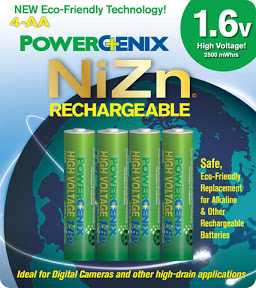
Meet the nickel-zinc battery!
This is what the omniscient Wiki writes about these elements:

This type of battery was invented by Edisson more than 100 years ago, but only recently the technology has reached the production of usable elements. To date, they, alas, are commonly available only in AA format, plus C and D formats for commercial applications. According to the characteristics of the discharge, they are very close to Nickel-Cadmium with one difference - (sound of fanfare!) The voltage on the element is 1.6 volts versus 1.2 for NiCd.

What it gives us - see below. And, of course, they lack two main disadvantages of cadmium batteries - the memory effect and toxicity for the environment. It is thanks to the second paragraph that the European Parliament recommended that European manufacturers curtail the production of nickel-cadmium batteries in favor of nickel-zinc batteries.
The next plus is a very small internal resistance, units of milli-mi, which makes it possible for us to obtain very large charging and discharging currents. In this parameter, NiZn can easily compete with lead batteries with 75% less specific weight per watt of stored energy. You can fully charge the battery in 2 hours, and this is its normal mode, and not super-violently accelerated in cadmium and lithium. There is a small nuance here - zinc cannot tolerate recharging, they must be fully charged (1.8v), and then wait until the voltage drops again to 1.6 volts, otherwise the released hydrogen - no, it will not explode - it will speed up the demise of the battery.
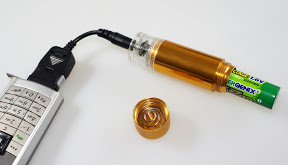
Well, this is not obvious for some plus:
ABOUT! How many times have I stepped on this rake !!! Have you tried to use a mobile phone or fotik in the cold? And it turned out? But zinc batteries do not have a fast self-discharge at low temperatures. Hurray-hurray, an ideal element for our electric vehicles, taking into account the winter.
In the course of testing, I rummaged through the apartment in search of devices on AA-sized elements. Brief summary - I liked it. More details:
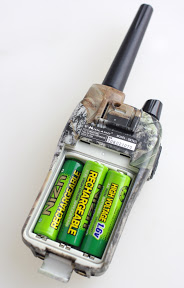
1) Radio station. The signal from the same walkie-talkie at a distance of 200 meters through 4 concrete walls was noticeably better and cleaner, I haven’t yet checked the range, but I’m going to check as soon as the rains end and there will be an excuse for going outdoors.
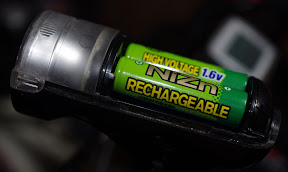
2) Bicycle lights. Tested two models, one left Chinese simply with a resistor and LEDs and one - Sigma Cube with a current stabilizer. The second one was shining the same way as before the experiment, it was clear that the question would be sooner in operation time, but I turned on the first one and turned it off immediately - it seems that the brightness has grown every two times, scared, no matter how the diodes burned out. In short, with the headlights, I still leave room for experimentation, here I have not thought of something in the preparation of experiments.

3) Camera. Well, I'm not so special as to discuss the saturation of colors or the transmission of half tones with a smart look, but in my view of Dummies it is subjectively better, and the flash reloads three times faster, and the lens moves faster.
4) Remote from telly. Programs switched from another room with reflection from the wall in the hallway. Even batteries did not give such an effect.
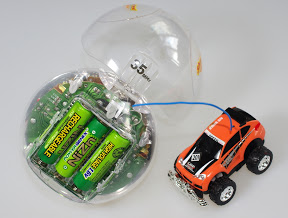
5) All sorts of toys. I didn’t seriously test, because ... well ... you know :)
And now about the minuses:
1) The number of recharges is three times less than that of the hydride counterparts. Well, this is such a conditional minus - I and nickel-hydrides were lost or spoiled long before the end of the resource :)
2) One of my favorite chips for making LED headlights LTC3490 has an input voltage limit of 3.2 volts. Two batteries or alkalines fit into this restriction, two nickel-zinc - alas ... And putting them one at a time is two times less than the time between replacement of elements. It will have to come up with the following scheme to switch between elements.

3) The most painful is a separate charger. Again, as far as my intuition does not change me - in an emergency, I will be able to charge these batteries by 60-70% in the usual charger for NiMH. But all the same - we will look for / solder universal chargers.
4) Price: (We will wait until these batteries get more widespread, but for the time being, for the price of one zinc one can buy two good nickel-cadmium or a couple of dozen half-time Chinese-cadmium ones.
5) It’s rather from the joke area - on photo forums it’s discussed that when using such batteries in flashes during continuous shooting, the flash overheats very quickly - with ultrafast recharging, there is no time for it to cool down.
Summary:
I finally said goodbye to metal hydride and switch to a new technology. It is better not to regret a little money, but to have one and a half times more energy in a photo or a spotlight is like seat belts, some people are skeptical, but one day they can save your life. Well, or at least a good frame on the fotik;)

Meet the nickel-zinc battery!
This is what the omniscient Wiki writes about these elements:

This type of battery was invented by Edisson more than 100 years ago, but only recently the technology has reached the production of usable elements. To date, they, alas, are commonly available only in AA format, plus C and D formats for commercial applications. According to the characteristics of the discharge, they are very close to Nickel-Cadmium with one difference - (sound of fanfare!) The voltage on the element is 1.6 volts versus 1.2 for NiCd.

What it gives us - see below. And, of course, they lack two main disadvantages of cadmium batteries - the memory effect and toxicity for the environment. It is thanks to the second paragraph that the European Parliament recommended that European manufacturers curtail the production of nickel-cadmium batteries in favor of nickel-zinc batteries.
The next plus is a very small internal resistance, units of milli-mi, which makes it possible for us to obtain very large charging and discharging currents. In this parameter, NiZn can easily compete with lead batteries with 75% less specific weight per watt of stored energy. You can fully charge the battery in 2 hours, and this is its normal mode, and not super-violently accelerated in cadmium and lithium. There is a small nuance here - zinc cannot tolerate recharging, they must be fully charged (1.8v), and then wait until the voltage drops again to 1.6 volts, otherwise the released hydrogen - no, it will not explode - it will speed up the demise of the battery.

Well, this is not obvious for some plus:
ABOUT! How many times have I stepped on this rake !!! Have you tried to use a mobile phone or fotik in the cold? And it turned out? But zinc batteries do not have a fast self-discharge at low temperatures. Hurray-hurray, an ideal element for our electric vehicles, taking into account the winter.
In the course of testing, I rummaged through the apartment in search of devices on AA-sized elements. Brief summary - I liked it. More details:

1) Radio station. The signal from the same walkie-talkie at a distance of 200 meters through 4 concrete walls was noticeably better and cleaner, I haven’t yet checked the range, but I’m going to check as soon as the rains end and there will be an excuse for going outdoors.

2) Bicycle lights. Tested two models, one left Chinese simply with a resistor and LEDs and one - Sigma Cube with a current stabilizer. The second one was shining the same way as before the experiment, it was clear that the question would be sooner in operation time, but I turned on the first one and turned it off immediately - it seems that the brightness has grown every two times, scared, no matter how the diodes burned out. In short, with the headlights, I still leave room for experimentation, here I have not thought of something in the preparation of experiments.

3) Camera. Well, I'm not so special as to discuss the saturation of colors or the transmission of half tones with a smart look, but in my view of Dummies it is subjectively better, and the flash reloads three times faster, and the lens moves faster.
4) Remote from telly. Programs switched from another room with reflection from the wall in the hallway. Even batteries did not give such an effect.

5) All sorts of toys. I didn’t seriously test, because ... well ... you know :)
And now about the minuses:
1) The number of recharges is three times less than that of the hydride counterparts. Well, this is such a conditional minus - I and nickel-hydrides were lost or spoiled long before the end of the resource :)
2) One of my favorite chips for making LED headlights LTC3490 has an input voltage limit of 3.2 volts. Two batteries or alkalines fit into this restriction, two nickel-zinc - alas ... And putting them one at a time is two times less than the time between replacement of elements. It will have to come up with the following scheme to switch between elements.

3) The most painful is a separate charger. Again, as far as my intuition does not change me - in an emergency, I will be able to charge these batteries by 60-70% in the usual charger for NiMH. But all the same - we will look for / solder universal chargers.
4) Price: (We will wait until these batteries get more widespread, but for the time being, for the price of one zinc one can buy two good nickel-cadmium or a couple of dozen half-time Chinese-cadmium ones.
5) It’s rather from the joke area - on photo forums it’s discussed that when using such batteries in flashes during continuous shooting, the flash overheats very quickly - with ultrafast recharging, there is no time for it to cool down.
Summary:
I finally said goodbye to metal hydride and switch to a new technology. It is better not to regret a little money, but to have one and a half times more energy in a photo or a spotlight is like seat belts, some people are skeptical, but one day they can save your life. Well, or at least a good frame on the fotik;)
')
Source: https://habr.com/ru/post/89264/
All Articles